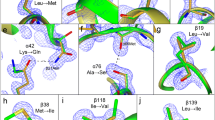Abstract
We report the 94 % assignment of DVU2108, a protein belonging to the Orange Protein family, that in Desulfovibrio vulgaris Hildenborough forms a protein complex named the Orange Protein complex. This complex has been shown to be implicated in the cell division of this organism. DVU2108 is a conserved protein in anaerobic microorganisms and in Desulfovibrio gigas the homologous protein was isolated with a novel Mo–Cu cluster non-covalently attached to the polypeptide chain. However, the heterologously produced DVU2108 did not contain any bound metal. These assignments provide the means to characterize the interaction of DVU2108 with the proteins that form the Orange Protein complex using NMR methods.


Similar content being viewed by others
References
Bursakov SA et al (2004) Antagonists Mo and Cu in a heterometallic cluster present on a novel protein (orange protein) isolated from Desulfovibrio gigas. J Inorg Biochem 98:833–840. doi:10.1016/j.jinorgbio.2003.12.002
Carepo MS, Pauleta SR, Wedd AG, Moura JJ, Moura I (2014) Mo–Cu metal cluster formation and binding in an orange protein isolated from Desulfovibrio gigas. J Biol Inorg Chem 19:605–614. doi:10.1007/s00775-014-1107-8
Cort JR, Yee A, Edwards AM, Arrowsmith CH, Kennedy MA (2000) NMR structure determination and structure-based functional characterization of conserved hypothetical protein MTH1175 from Methanobacterium thermoautotrophicum. J Struct Funct Genomics 1:15–25
Etezady-Esfarjani T, Herrmann T, Peti W, Klock HE, Lesley SA, Wuthrich K (2004) NMR structure determination of the hypothetical protein TM1290 from Thermotoga maritima using automated NOESY analysis. J Biomol NMR 29:403–406. doi:10.1023/B:JNMR.0000032615.51536.1a5274592
Ferentz AE, Wagner G (2000) NMR spectroscopy: a multifaceted approach to macromolecular structure. Q Rev Biophys 33:29–65
Fievet A et al (2011) The anaerobe-specific orange protein complex of Desulfovibrio vulgaris hildenborough is encoded by two divergent operons coregulated by sigma54 and a cognate transcriptional regulator. J Bacteriol 193:3207–3219. doi:10.1128/JB.00044-11JB.00044-11
George GN et al (2000) A novel protein-bound copper–molybdenum cluster. J Am Chem Soc 122:8321–8322. doi:10.1021/Ja000955h
Hansen TA (1994) Metabolism of sulfate-reducing prokaryotes. Antonie Van Leeuwenhoek 66:165–185
Heidelberg JF et al (2004) The genome sequence of the anaerobic, sulfate-reducing bacterium Desulfovibrio vulgaris Hildenborough. Nat Biotechnol 22:554–559. doi:10.1038/nbt959nbt959
Lowry OH, Rosebrough NJ, Farr AL, Randall RJ (1951) Protein measurement with the Folin phenol reagent. J Biol Chem 193:265–275
Muyzer G, Stams AJ (2008) The ecology and biotechnology of sulphate-reducing bacteria. Nat Rev Microbiol 6:441–454. doi:10.1038/nrmicro1892nrmicro1892
Najmudin S, Bonifacio C, Duarte AG, Pauleta SR, Moura I, Moura JJ, Romao MJ (2009) Crystallization and crystallographic analysis of the apo form of the orange protein (ORP) from Desulfovibrio gigas. Acta Crystallogr Sect F Struct Biol Cryst Commun 65:730–732. doi:10.1107/S1744309109023392S1744309109023392
Pauleta SR, Duarte AG, Carepo MS, Pereira AS, Tavares P, Moura I, Moura JJ (2007) NMR assignment of the apo-form of a Desulfovibrio gigas protein containing a novel Mo–Cu cluster. Biomol NMR Assign 1:81–83. doi:10.1007/s12104-007-9022-3
Rabus R, Hansen T, Widdel F (2006) Dissimilatory sulfate- and sulfur-reducing prokaryotes. In: Dworkin M, Falkow S, Rosenberg E, Schleifer K-H, Stackebrandt E (eds) The prokaryotes. Springer, New York, pp 659–768. doi:10.1007/0-387-30742-7_22
Scholten JC, Culley DE, Brockman FJ, Wu G, Zhang W (2007) Evolution of the syntrophic interaction between Desulfovibrio vulgaris and Methanosarcina barkeri: involvement of an ancient horizontal gene transfer. Biochem Biophys Res Commun 352:48–54. doi:10.1016/j.bbrc.2006.10.164
Sharma D, Rajarathnam K (2000) 13C NMR chemical shifts can predict disulfide bond formation. J Biomol NMR 18:165–171
Shen Y, Delaglio F, Cornilescu G, Bax A (2009) TALOS+ : a hybrid method for predicting protein backbone torsion angles from NMR chemical shifts. J Biomol NMR 44:213–223. doi:10.1007/s10858-009-9333-z
Wishart DS, Sykes BD (1994) The 13C chemical-shift index: a simple method for the identification of protein secondary structure using 13C chemical-shift data. J Biomol NMR 4:171–180
Acknowledgments
This work was supported by a research project from the Fundação para a Ciência e Tecnologia (FCT-ANR/BBB-MET/0023/2012) to SRP, which also supported the NMR spectrometer (RECI/BBB-BQB/0230/2012), which is part of the National NMR Network. MSPC would like to thank CAPES-BJT programme for financial support.
Author information
Authors and Affiliations
Corresponding author
Rights and permissions
About this article
Cite this article
Neca, A.J., Soares, R., Carepo, M.S.P. et al. Resonance assignment of DVU2108 that is part of the Orange Protein complex in Desulfovibrio vulgaris Hildenborough. Biomol NMR Assign 10, 117–120 (2016). https://doi.org/10.1007/s12104-015-9648-5
Received:
Accepted:
Published:
Issue Date:
DOI: https://doi.org/10.1007/s12104-015-9648-5




